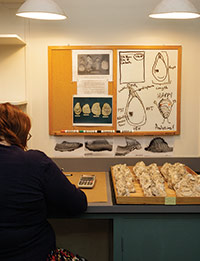History on the Half Shell
Three years, 14,000 oysters, and the story of America's beginnings.
by Gil Klein
Photography by Tom Green
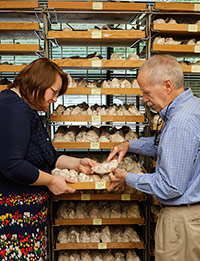
Oyster shells from an excavation at the Wren South site in Williamsburg line shelves in the Foundation's zooarchaeological laboratory Dessa Lightfoot and Stephen Atkins share.
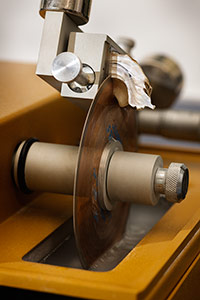
Oyster-shell specimens are sectioned by a spinning blade, allowing anthropologists to examine details on a microscope slide.
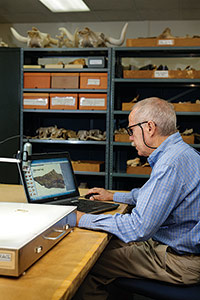
Modern tools, such as this microscope that can be attached to a computer, allow Atkins to get a close look at his subject.
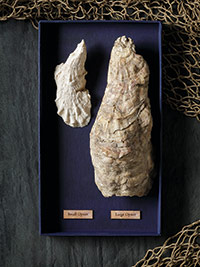
The height and length of the shells offer clues about whether the specimen is a bed, sand, channel or reef oyster. Smaller shells indicate that a demanding consumer market may have forced oysters to be harvested before they were full grown.
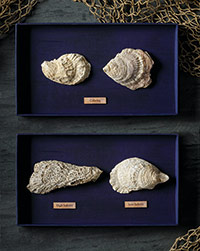
Color, ribbing and the presence or absence of parasites all tell stories about the oysters. For example, the shells pierced by parasites were products of saltier water while fresh water oysters have no holes in their shells.
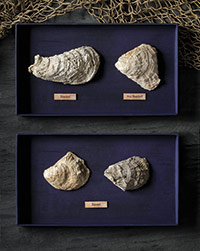
Everything - down to whether the oyster was ever opened - tells a story. Evidence of burned oyster shells, which were used to make lime for building materials, could give a sense of where people were putting down roots.
In the early years of the 18th century, students at the College of William & Mary enjoyed their oysters, and thousands of shells were discarded into a sawpit near the Wren building, supposedly lost to time.
Would anyone care about dinner trash?
During an excavation of the pit, two Colonial Williamsburg anthropologists saw value in those old shells. Last fall, they organized 11 volunteers to form an assembly line outside the Foundation's Archaeological Collections Building. They washed 15 5-gallon buckets full of shells, one by one.
"In two days, we washed all of the shells from that one giant context of oysters at the Wren," said Stephen Atkins, Colonial Williamsburg's associate curator of environmental archaeology. "That would have taken weeks and weeks to do at the lab. And it was fun."
Oysters are one of the most ubiquitous historic relics of the Chesapeake Bay area. Native Americans discarded mounds of them before the European settlers arrived. Capt. John Smith wrote that the mollusks were "thick as stones" as he explored the Bay and rivers. Reefs of oysters were a menace to wooden ships.
Oysters sustained the earliest settlers, and historians hypothesize that they may have saved Jamestown during the starving time. They were gathered for local consumption and then harvested for export to nearby cities and even to Caribbean islands. Oyster shells are still used on paths in Colonial Williamsburg's Historic Area.
But isn't one shell just like another? What possibly can be learned by studying each one, let alone more than 14,000 that already have been processed for this project?
At Colonial Williamsburg Foundation's Environmental Laboratories of Collections, Conservation, and Museums, that's what Atkins and environmental laboratory technician Dessa Lightfoot are trying to figure out.
Atkins' interest in shells dates back to when his parents moved to Indian Harbour Beach on an east coast Florida barrier island when he was 10 years old. The family home was built on a prehistoric shell midden. Along the shore, he found pottery and bones that inspired him to read about them and use them for science fair projects.
He earned a bachelor's degree in anthropology at the University of Florida, and his graduate work at the College of William & Mary brought him to Williamsburg in 1987.
At the same time, Colonial Williamsburg was launching an environmental archaeology program that would tie the man-made artifacts with biological remnants to create a nuanced study of life past. Atkins' work at William and Mary caught the attention of Joanne Bowen, Colonial Williamsburg's curator of environmental archaeology, and by 1990 he was working full time in the laboratories located just outside the Historic Area.
Lightfoot's story is similar. She spent her summers with her grandparents on Cape Cod, where she collected shells and beach glass. The erosion on a bluff near their cabin had exposed layers of deposits that dated to the cape's settlement. After earning her undergraduate degree in English, she graduated with a master's degree in archaeology and anthropology from the University of New Mexico. Now pursuing a Ph.D. at William and Mary, she has worked with Colonial Williamsburg since 2011.
Atkins and Lightfoot share the zooarchaeology laboratory surrounded by trays and shelves filled with animal bones and skulls that are used to help identify animal remains found during archaeological digs. They may examine specimens as large as ox skulls and as tiny as pollen samples to get an idea of the entire environment that existed at the time.
"It's all food waste, the diet of people who were here," Atkins said. "We have recipe books and diaries where people wrote about what they ate. But you don't write about what you eat every day, which is what we are trying to get to here.
"If we look at the everyday food remains, we can tell the difference in the diet of a middling farmer and a tradesperson and a slave," he said. "We can tell what part of the diet was domestic and what part wild, and how it changed over time."
Beyond just the food, Lightfoot said, they are studying what the remains say about systems of marketing, systems of animal husbandry and agricultural practices.
"Because we are part of Colonial Williamsburg," she said, "our primary focus is on using that information to interpret what was happening here in the 17th, 18th and 19th centuries to make sure what is being presented in the public areas are things that we know through archaeological and historical research."
And that brings us back to oysters.
Atkins and Lightfoot have identified nine sites where they can link oyster shells from archaeological excavations with specific time periods for those three centuries. Shells have been collected at the Public Armory, the Atkinson site, the Brush-Everard House, the Brafferton Indian School, R. Charlton's Coffeehouse, Rich Neck Plantation and the Wray site. Work is still underway at the Peyton Randolph house and the Wren South Yard.
Oyster shells from each site are individually examined by lab volunteers for size, shape, color and signs of parasites. The information is meticulously recorded so that trends can be spotted.
Begun in 2011, the work has been funded by Peri and Peg Urvek, E. Marshall Tucker and Mr. and Mrs. Donn Starkey as well as the Mary and Donald Gonzales Field Experience Fund.
While four years and 14,000 oyster shells may sound like a lot of work, Atkins said, the study still has a long way to go.
"It sounds silly to say we have analyzed more than 14,000 shells and we are just starting to get enough data to look at what was going on in Williamsburg across time," Lightfoot said. "You really need a lot of shells from a lot of different sites to make good interpretations."
Oysters in their natural state come in a variety of shell shapes. In the earliest days, when settlers collected oysters for personal consumption, they probably didn't care what the shells looked like. The earliest excavations indicate oysters as a food source but not a commercial source.
But shells coming from sites in the 18th century tend to be uniform in height and shape. That indicates a shared understanding of what constitutes a good oyster for eating.
"When you see a high degree of uniformity that is often a hallmark of a market system," Atkins said. "Consumers are demanding a consistent product, which harvesters are then seeking out and providing."
They also are seeing a slight fluctuation in oyster size based on the population of Williamsburg. Oyster shell sizes get smaller as the population grows, indicating oysters were being harvested faster than they could grow back.
"Toward the end of the 18th century and moving into the 19th century, it gets a little weird," Lightfoot said. "There are lots of potential reasons. Disruption from the Revolutionary War drove people away from waterways because the British were raiding plantations. We see harvesting moving upriver, away from the mouths of rivers and away from the political strife going on."
How can they tell that? Oysters living in saltier water are attacked by parasites that gouge into their shells. Oysters living in brackish water have much smaller holes in their shells. Oysters in fresher water have no holes. It takes even an amateur only a couple of minutes to be able to identify the difference.
By checking the salinity of nearby rivers and tributaries coming into the Chesapeake, Atkins said, they can get a general idea of where the oysters were harvested.
"It doesn't give us an exact location, but it tells us whether it is closer to the mouth of the Chesapeake or it is farther upstream, so we can see how harvesting changed over time," Lightfoot said.
And the shell provides other clues about the oyster's life.
"We measure the height and length to get the ratio to determine if they are bed, sand, channel or reef oysters," Atkins said. "We look at ribbing, coloring, different types of parasites. We will try to get relative age by examining the hinge area."
A shrinking population in Williamsburg after the capital moved to Richmond didn't lead to an expected result. The shells didn't get bigger, Lightfoot said.
"Oyster size keeps going down and down," she said. "So it's not related to what's happening in the local population. It means they must be harvesting oysters to be sold somewhere else, to the surrounding cities."
That, she said, is evidence of the growing export market.
Science can tell the researchers in what season the oysters were harvested and how old they were when they were pulled from the water. Oysters grow like trees, Atkins said, so that summer fast growth seasons and winter slow growth show up like tree rings on its hinge area.
In the laboratory, Atkins extracts an extremely thin slice from the hinge of an oyster shell for a test known as oxygen isotope profiles. These samples are sent to the Florida Museum of Natural History and are then submitted for analysis to the Light Stable Isotope Mass Spectrometry Lab at the Department of Geological Sciences, University of Florida.
So far, the researchers have examined data on three shells from each time period — from the Rich Neck Plantation in the late 17th century, from the Public Armory in the late 18th century, and from the Brafferton Indian School in the late 19th century.
The tests measure the shell's chemical properties, which yield information about the temperature of the water. That in turn tells researchers about the season during which the oysters were harvested, as well as their age. An enriched oxygen result indicates a winter harvest, while a depleted oxygen result would point to summer.
Test results show that the three oysters — spanning more than 200 years — were harvested in the late fall or early winter — all months with the letter "r" in them.
You may remember your grandmother telling you to eat oysters only in months that have an "r" if you want to avoid getting sick, Lightfoot said. While it's unlikely that a summer oyster will make you sick, the work by Atkins and Lightfoot is showing that eating oysters in the fall and winter is a food practice that dates to America's first settlers.
"What people ate and how they ate it is very different now than it was centuries ago," Lightfoot said. "But here we have something consistent from the 17th century to the 21st century. The past is usually different and sometimes weird. So it's always cool to see a tradition that spans across time."
Oysters were not just used for food. Burnt oyster shells were used to make lime for building materials such as concrete, mortar and tabby that were used to build the original Williamsburg town.
Atkins and Lightfoot are looking for evidence of other uses.
"A volunteer went through The Virginia Gazette to find all references to oysters," Lightfoot said, referring to the newspaper published while Williamsburg was the capital. "One of the references she found was the use of ground-up oyster shells as a potential cure for rabies, although I can't imagine it was very effective."
Oysters are filter-feeding animals. They take in surrounding water, filter out the nutrients and expel clean water. When Capt. John Smith explored the Chesapeake Bay, oysters were so plentiful that they could recycle a volume of water equal to the entire Bay (18 trillion gallons) in less than a week, according to the Chesapeake Bay Foundation.
Over the intervening four centuries, those oysters were overfished and their reefs destroyed. Pollution and disease have devastated their population. The few that remain would take about a year to filter that much water. Now modern-day researchers are seeking ways to rebuild the reefs and restock the oysters.
All of this history is etched in the 14,000 shells — and counting — that Atkins and Lightfoot are examining to interpret part of the story of Colonial Williamsburg. For them, it can be as personal as what a William and Mary student ate in 1710 and it's as broad as the role of oysters in the British-American mercantile system before the Revolution.
When Lightfoot talks to the youngsters participating in DIG!, Colonial Williamsburg's summer archaeological program for kids, she can tell the fascinating stories about how the lowly oyster shell can tell tales of history — just as she and Atkins had their imaginations piqued by the shells they found on their childhood beaches.

